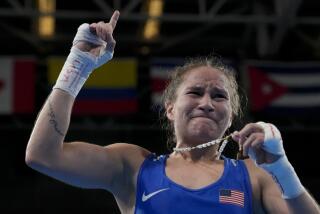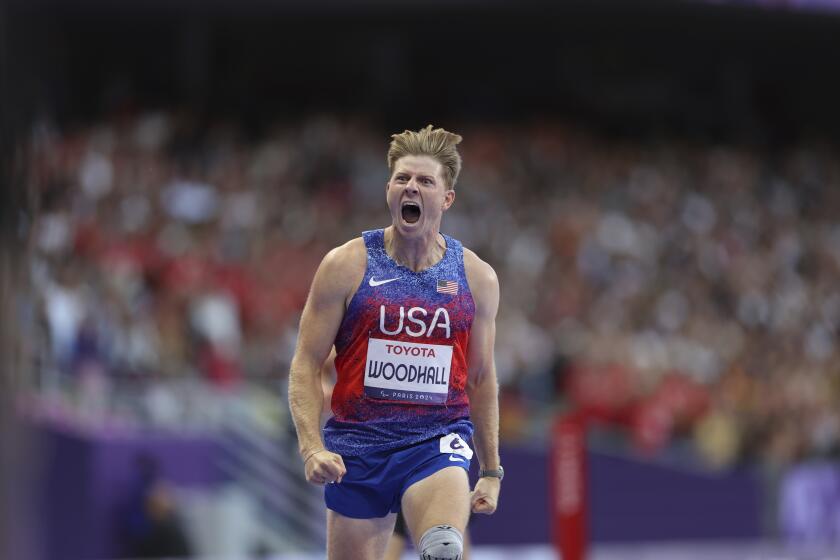RING OF GOLD : A LOOK AT THE 1984 U.S. OLYMPIC BOXING TEAM : His Torch Burns Out : WHILE DE LA HOYA GETS RICH, GONZALES GIVES HIM A PARTING SHOT--AND WONDERS WHERE THE TIME WENT
Paul Gonzales throws verbal combinations at the latest Grim Reaper, making believe it is 1984 again and he is the one and only Kid Barrio.
Retirement? No way. Never.
“What, you crazy?”
Stick and move.
It is a Thursday afternoon at the Hollenbeck Youth Center in East Los Angeles and, if one is willing to ignore the obvious, turning back the clock is not difficult.
Same musty gym. Same crusty trainer, Al Stankie. Same fighter, Paul Gonzales.
The Cop and the Kid. They were going to make a movie. As boxer skips rope and trainer tends to paperwork, you half expect the phone to ring and a fight card to break out.
But this is 1994.
Upon closer inspection, Stankie’s hair, pulled back into a ponytail to make a 53-year-old man look hipper, is streaked with gray.
And gravity has at last chased down a now full-faced Gonzales, 30 pounds heavier than the flyweight who 10 years ago Thursday, a few blocks away at the Sports Arena, became the first Latino to win an Olympic gold medal.
“Where did the time go?” Stankie wonders.
Time, in fact, has come calling for Gonzales’ gloves. It isn’t that simple, though, so the fighter continues to box his shadow.
In another room, Stankie acknowledges that he doesn’t know how to break the news to Kid. They’ve been Mutt and Jeff going on 20 years, ever since Stankie, then an LAPD officer, rescued the 9-year-old street punk from the barrio, taught him to box, took him into his home, then turned him into an Olympic champion.
“When do you give up the ghost?” Stankie asks. “When does a ballplayer hang up his gloves, a hockey player his skates? When is it time?”
For Gonzales, the time is now. After a four-year rupture in the relationship, reportedly the result of Stankie showing up drunk at one of Gonzales’ fights in 1989, the trainer, who has since undergone alcohol rehabilitation, has returned to the corner, if only to tie up loose ends.
Gonzales still calls Stankie “Pop.” And Stankie still calls Gonzales “Son.”
During a professional decade strewn with confounding injuries, bad luck and questionable business decisions, Gonzales fought only 22 times.
The 30-year-old Gonzales scored his 18th--and probably last--victory in February.
It is clear that Stankie has returned for purposes of preservation, not resurrection.
“I could give him a fight with a phone call,” Stankie says. “He’s not a bum. He’s still an Olympic champion.”
But . . .
Stankie, father protector, is not about to allow some up-and-comer to stomp on Gonzales’ good name for promotional purposes.
History will reflect that Gonzales’ dream fell several punches short. He never became a millionaire, or wore a world championship belt.
Worse, after blazing the Latino trail out of the barrio, Gonzales has watched Oscar De La Hoya steal his poor-East-L.A.-boy-makes-good script and run off with the riches.
Cashing in on his Olympic fame, De La Hoya recently landed a $7.5-million contract with HBO. Gonzales never made six figures for a bout.
Envy?
“There has to be, whether he admits it or not,” says Don Chargin, who promoted more than half of Gonzales’ fights. “Paul had all the bad breaks, while De La Hoya has had it really easy.”
Gonzales insists he is not jealous of De La Hoya. But don’t rule out contentious.
“People say, ‘Do you know Oscar?’ and I say ‘Yeah, he’s my shadow,’ ” Gonzales says. “That’s what he is, my shadow. Paul Gonzales paved the road for a lot of Hispanics. Now, a lot of them are getting what I should have gotten. But it’s not too late.
“I’m the first, I’ll always be the first. They’ll always be the second, or third, or fourth. Paul Gonzales will be the prince of the barrio.”
Their stories are virtual parallels, to the degree that De La Hoya built a home for his family in Montebello only a few blocks from the home Gonzales had built for his mother, Anna, 10 years ago.
The rift between Gonzales and De La Hoya stems from a magazine story last year in which De La Hoya criticized Gonzales for saying in so many words that he considered himself an American first, then a Mexican.
Gonzales has been counterpunching ever since.
“I would love to crack him on the chin,” Gonzales says. “He’s got a big mouth, and I’d like to shut it. The guy’s a punk, a snake.”
Publicly, though, only Gonzales spews venom.
De La Hoya claims to harbor no ill feelings.
“I have lots of respect for Paul Gonzales,” De La Hoya said when informed of Gonzales’ comments. “I remember how we were close buddies not too long ago. But I guess there was a bad interview in a magazine or something, and he saw it and didn’t like it. But I still respect him. I look at him as the first one who did it.”
You suspect it is De La Hoya’s success that keeps Gonzales sparring in dank gyms.
“That guy has nothing to do with it,” Gonzales snaps. “He doesn’t motivate me, because I’m never going to fight him. If they would fight me, then I would say, ‘Let’s do it.’ I’d love to fight him.”
Gonzales, once a wisp of a fighter, has fattened up to 135 pounds. De La Hoya tipped the scales at 135 for his impressive victory over Jorge Paez in Las Vegas on July 29.
“I’d fight him,” Gonzales says. “It would be one last fight. Him. The guy hasn’t proven anything to me. I’d just like to shut his mouth. He’s a joke. He’s a paper champion.”
As he dresses down De La Hoya, Gonzales is 20 again. His eyes are saucers, his smile wide. He is the prince.
How does one retire from such exhilaration?
“It’s the thrill of the fight,” Gonzales says with almost religious fervor. “That’s what it is. When you’re in there, going blow to blow, it just feels so wonderful. When you’re making the guy do what you want him to do, you’re slapping him around, hitting him with combinations. You stand back and look at your work of art.”
As De La Hoya’s entourage swells, Gonzales cannot help but see himself in the picture. On good days, in his mind’s recesses, he still imagines it can happen for him.
*
Where did the time go?
Gonzales walked away from the 1984 L.A. Games with star potential nearly matching De La Hoya’s after Barcelona in 1992.
But there were differences. The money for lighter weight fighters 10 years ago was paltry. Gonzales thinks he helped to change that.
Also, the year Gonzales won gold, eight other American boxers were also Olympic champions.
In 1992, De La Hoya was the only American gold medalist in boxing.
“Can the American public even remember who those nine gold-medal winners were from ‘84?” Stankie says. “But you ask that same group in 10 years, ‘Who won the gold in ‘92?’ and everyone is going to say Oscar De La Hoya. Yeah, that’s got to bug Paul.”
More than anything, Gonzales was a million-dollar boxer trapped in a two-bit frame.
“The best way to explain Paul Gonzales is that he’s got a lion’s heart in a sparrow’s body,” Stankie says.
Gonzales started breaking down during the L.A. Games. In his opening light flyweight bout against Kim Kwang-Sun of South Korea, he suffered three broken bones in his right hand. In his second bout, against Uganda’s William Boganzo, Gonzales suffered a dislocated right elbow and shoulder.
Before his third-round victory over Great Britain’s Jim Lyon, Gonzales suffered a broken toe jogging.
But nothing could detour him from the gold. It was this relentlessness Stankie saw in the 9-year-old PeeWee fighter who would continue to throw haymakers even after getting knocked down.
In his Olympic title fight, Gonzales dragged assorted parts into the ring and took the gold by default when Salvatore Todisco of Italy appeared with a cast on his hand, the result of a broken thumb suffered in his semifinal bout.
Gonzales’ pro career was derailed for nearly a year by post-Olympic hand surgery. And after that, there were more doctor than fight bills.
Some boxers have hands of stone.
“Paul’s are more like a piano player’s,” Chargin says.
Gonzales suffered a broken left hand in 1986. In 1987, he suffered a knee injury after somehow running his Corvette over his own leg. In 1988, he suffered a broken hip.
In the ring, he scored modest successes, winning the North American Boxing Federation’s flyweight title in his third fight. In 1988, as a bantamweight, he won the World Boxing Assn.’s Intercontinental championship.
Gonzales remains the only man ever to have beaten Orlando Canizales. He defeated him in a 1986 non-title bout, then Canizales, the reigning International Boxing Federation bantamweight champion, avenged the loss in a 1990 rematch.
Gonzales’ career has mostly been disappointments and postponements.
“I’ve cried myself to sleep asking God why,” Gonzales says. “What did I do that was so wrong that every time I hit somebody, I break something?”
Gonzales took calcium pills and other concoctions in vain attempts to strengthen his bones. He still holds out hope that he will be able to continue without hearing something snap.
But in the course of an interview ostensibly about his future, Gonzales starts slipping into the past tense.
“When I was in that ring, uh, I mean when I’m in that ring, I’m poetry in motion,” he says. “I don’t care who you are, I’ll beat you.”
Because expectations were so high, the Gonzales story often loses context. Once, he was a kid headed nowhere fast. The oldest of eight children, his father out of the picture, Gonzales followed a familiar path to the streets.
There could have been worse endings.
When Gonzales needs reminding, he makes the short trip to the Coliseum to literally feel his name, chiseled in stone for posterity along with those of other Olympic champions.
Or, he goes to the bank and gets his gold medal from a safe-deposit box. In his post-Olympic delirium, the gold medal never left Gonzales’ neck.
“I took a shower with it,” he recalls. “Went swimming with it, went to bed with it.”
Now, he visits it.
“Gold belongs in a bank, right?” he says.
At the Hollenbeck Youth Center, children still stand in line for his autograph, as though he had won the gold medal last week. None care that Gonzales did not “live up to expectations.”
Gonzales takes his time with signature seekers, personalizing each request with a special message of inspiration.
In moments of self-pity, Gonzales fingers the back of his head and remembers how it might have been.
“I’ve got these little knots, scars,” he says. “From the buckshot.”
He was riding in a car, a young gangster, when a shotgun blast nearly killed him.
“It hit the window and ricocheted,” he says, explaining his good fortune. “Or else I’d be dead.”
Because he is not, Gonzales can devote his days to motivational speaking and drug-prevention campaigns. His words ring true in the community.
Gonzales lived to answer the knock at his door not long ago. Before him stood a teen-ager he had never met, who asked only that he might hug the boxer.
“He said, ‘If it wasn’t for you, I wouldn’t be here,’ ” Gonzales says. “He said he had been in and out of prison, involved in gangs, that he had been shot, but got away (from the gangs). He said, ‘If Paul Gonzales can do it, I can do it.’
“It choked me up.”
Gonzales never wore a world championship belt, but can still be found most days working out at the youth center where he was discovered.
“I don’t forget where I come from,” Gonzales says.
Which brings the subject back to De La Hoya.
“I know people who live around him and they tell me, ‘He’s forgotten who he is,’ ” Gonzales says. “ ‘He comes around the neighborhood flashing his money, or comes in a limo. What was he trying to do, show us that he’s better than us? He’s no better than us.’ They tell me, and it makes me feel good, they say, ‘Paul, you never forgot where you came from.’ ”
De La Hoya, sensing perhaps he has little to gain in this sparring match, refuses to enter the fray.
“He’s the gold-medal winner and that inspired me,” De La Hoya says of Gonzales. “It does bother me and I’m a bit frustrated, because I have nothing against him. He’s a nice guy and everything, and hopefully one day we can get along. It could be jealousy. It could be a lot of things. I don’t know what he’s feeling. I just hope we can be friends again. Because I don’t like having enemies.”
*
Paul Gonzales is not going to fight again.
At the conclusion of an adjective-packed interview--peppered with the usual boxing bravado and bombast--Gonzales at last lowers his head in a Hollenbeck Youth Center office and concedes that he is, indeed, finished.
He plans, in fact, to announce his retirement Thursday at the Amateur Athletic Foundation.
“I won the gold medal on Aug. 11,” he says softly. “I started my professional career on Aug. 11. And I’m definitely going to make my retirement announcement Aug. 11.”
The Cop and the Kid gave it their best shot. Aimed high and fell short.
“People will say of Paul, ‘Well, he never really made it,’ ” Stankie says. “But that’s kind of relative, isn’t it? Look at the other kids in the project who are in jail, or dead. Or working in shops. Well, did he make it or didn’t he make it?”
The talk about comebacks has been boxing bluster. And denial. Like a balloon with a slow leak, Gonzales bounded about the room for a spell but eventually ran out of air.
“I want to fight, that’s why I’m procrastinating,” Gonzales explains. “Aug. 11 is just around the corner. I’ve still got time.”
After that?
“It will definitely be permanent, that’s why I’m procrastinating,” he says of his retirement plans. “But once I make the announcement, it’s over. Ten years. Full circle. Closed it.”
Gonzales has one request for his farewell at the AAF.
“They have a torch there. What I want to do is have it lighted when I go there. Then, I want to turn it off. Just for that day.”
Times staff writer Tim Kawakami contributed to this story.
More to Read
Go beyond the scoreboard
Get the latest on L.A.'s teams in the daily Sports Report newsletter.
You may occasionally receive promotional content from the Los Angeles Times.








